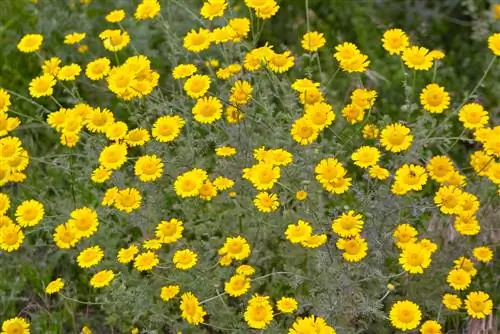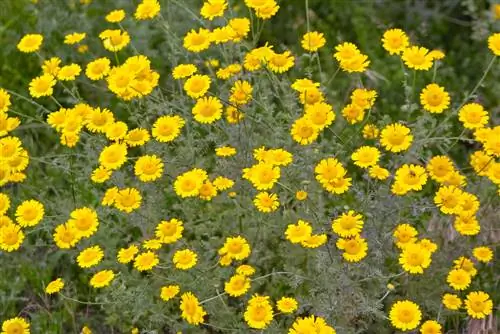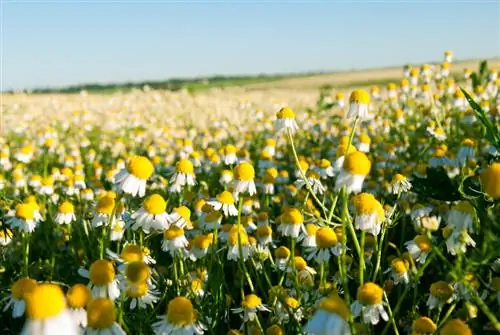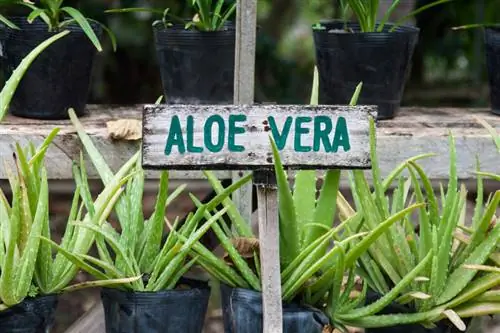- Author admin [email protected].
- Public 2023-12-16 16:46.
- Last modified 2025-06-01 06:02.
The dog chamomile is not only a species-rich wild perennial that is common in our country, it also works well in gardening as a pleasant addition to beds and as a cut flower for colorful bouquets. As a native plant, it is also extremely easy to care for.

What are the characteristics of dog chamomile?
The dog chamomile (Anthemis) is a species-rich wild perennial that is suitable as an easy-care bed enrichment and cut flower. It prefers poor, sandy or stony soils, loves sunlight and is largely immune to diseases. However, in contrast to real chamomile, it is slightly poisonous.
Origin
The genus of dog chamomiles, Latin Anthemis, with a total of around 100 species occurs primarily in Central and Southern Europe. Depending on the species, their distribution areas extend from northern Europe to southeastern areas such as Greece, Turkey, Israel and northern Africa.
In Germany, the frugal perennial prefers to inhabit stony ruderal areas, roadsides, dams and dry meadows. It is therefore adapted to habitats that are not really luxurious, which is also reflected in its very insensitive character. This means that it does not require much attention in gardening and can provide even inexperienced garden owners with an attractive flower bouquet.
Growth
Dog chamomiles grow either as annual, herbaceous plants or as perennials with minor woodiness. Depending on the species, they reach a height of around 20 to 50 centimeters. Their habit is characterized by the large, structurally rich leaves on the stems and the basket flowers typical of composite plants.
leaves
The leaves of dog chamomiles are attached alternately to the multi-branched, hairy stems and have a double-pinnate shape. The elongated, linear-lanceolate individual leaflets on the leaflets have a finely toothed edge. The foliage is usually grayish-medium green in color.
Flowers
As a daisy family, dog chamomile also has the characteristic, cup-shaped inflorescences about 2 ½ to 4 centimeters in diameter. They stand singly at the ends of the stems and have a hemispherical, sometimes slightly raised crest. The petal wreath is multi-layered, the individual leaflets have skin edges, are blunt and about half a centimeter to a whole centimeter long. Depending on the species, the flowers have a strong yellow to pale yellow or creamy white color. The flowering period is usually between June and September. The abundance of flowers is enormous and, especially with continuous cleaning, new flowers always form.
The flowers offer a great abundance of pollen and nectar and are often visited by bees and other beneficial insects. In this respect, it is also recommended to bring dog chamomile into the garden for a natural garden biological balance.
The flowers of the dyer's chamomile have another special property that is already anchored in their name. They contain an intense, yellow mordant dye that was previously primarily used to dye textiles.
Flower properties at a glance:
- Typically cup-shaped flowers approx. 2 ½ to 4 cm in diameter
- Self-employed
- Multilayer Petal Wreath
- Yellow to creamy white color
- Long flowering period between June and September
- Valuable insect pasture
Fruit
After flowering, dog chamomiles produce elongated, cylindrical to conical fruits with an angular cross-section. Numerous seeds are formed in the fruit, through which the dog chamomile seeds itself effectively. In this way, it secures its existence in a very reliable way, despite the rather limited lifespan of the individual plants.
Location
The dog chamomiles are often found in nature and their preferred settlement areas reveal their location requirements - which are generally not particularly demanding. It usually grows where other plants would not set foot (or root) - the chamomile feels very comfortable on stony construction sites or on railway embankments and can give these otherwise rather desolate areas a cheerful touch.
In general, dog chamomile likes poor, sandy to stony soil without a lot of nutrients. Anyone who otherwise has difficulty getting anything to bloom with stony garden soil will find a grateful customer in dog chamomile. The only thing she wants a lot of is sunlight. What she doesn't want to know about, however, is waterlogging. A clayey, water-retaining soil is not for them at all. Above all, frost can be dangerous in winter.
Because it likes stony soil, dog chamomile is ideal for planting in rock gardens. If you want to bring a little flower color and a homely, simple charm to your rock garden, we recommend the Anthemis. Some varieties also form very dense cushions, so that they can function as colorful ground cover.
Location requirements at a glance:
- Generally very undemanding
- Prefers sandy to stony, poor soils
- Unfavorable: water-retaining, clayey soils
- Loves the sun
- Good for rock gardens
Planting spacing
If you want to plant an area in the bed with chamomile, the planting distance depends on the type and variety you have chosen. The many variants reach slightly different sizes and sometimes form looser and sometimes denser clumps. For smaller and more loosely spreading species such as silvery mountain chamomile, you should stick to around 9 to 12 plants per m². For densely growing, larger species such as garden chamomile, you need fewer specimens, around 4-5 per m².
In general, the larger your planting plan should be, the more plants you should plant.
Cutting
In order to give dog chamomiles a vitalizing boost, it is recommended to cut them back after they have bloomed, i.e. around the end of September. This allows them to collect some energy for the winter. You should always cut off spent flowers as soon as possible to encourage new growth.
Dog chamomiles retain their flowers for a long time even after the entire plant has been cut. This makes them ideal as cut flowers for bouquets.
To remember:
- Strengthening treatment by pruning after the main flowering - preparation for winter
- Continuously clean out faded flowers
- Also lasts a long time as a cut flower
hardy
Basically, most perennial dog chamomiles are hardy. So they can easily be planted outdoors permanently and don't have to be brought indoors in the fall. However, if the temperatures are very severe and the soil is not so permeable, you should definitely protect the plants by covering them with fir branches or burlap.
In the pot
You can also cultivate dog chamomiles in a bucket. So you can bring the feel-good flowers to your balcony or terrace - and with them buzzing visitors, who also provide a summery flair and can also pollinate any neighboring plants.
If you keep a dog's chamomile in a pot, you have to be a little more careful and careful when caring for it. Here, regular, if not particularly extensive, watering is necessary. Only water enough so that the pot ball does not dry out completely. A mixture of normal potting soil and a good proportion of sand is suitable as a substrate.
Pouring
The dog chamomile generally does not need any special watering. She generally likes it rather dry and dry. However, if you keep it in a pot, you should give it some water regularly. However, make sure that the substrate has good drainage and that no waterlogging can occur.
Fertilize
A special fertilizer is not necessary for dog chamomile - since it is adapted to poor soils, additional nutrients should be avoided. When growing in a container, if you value lush flowering, you can add some potassium and phosphorus-rich fertilizer if necessary - but very sparingly and in small doses.
Propagate
The dog chamomile ensures its survival on its own. In addition, it usually produces a large amount of seeds with which it reproduces itself. If you want to specifically multiply a chamomile, you can either rely on the seeds or use the cutting method.
Seed propagation
It is best to collect seeds from the ripened fruits of your existing dog chamomile crop at the end of September or beginning of October. It's best to store these over the winter. In spring, place them in planting trays with potting soil, which you place in a bright and relatively warm place. It is best to keep them evenly moist under foil until they germinate.
Cuttings
Dog chamomile can also be easily propagated via cuttings. This method is not so time-consuming and is possible, above all, during the entire main vegetation phase. Simply cut a young but well-developed shoot from the mother plant with a sharp knife. You can let it root in a growing substrate or simply in a glass of water.
Diseases
Dog chamomiles are not only very easy to care for because of their undemanding location, water and nutrient requirements, but are also virtually immune to all diseases. Even snails usually leave them alone.
Poisonous
Real chamomile has been valued as a medicinal plant for thousands of years and is used both externally and internally to calm, reduce inflammation, disinfect, relieve cramps and promote digestion. Unfortunately, dog chamomile cannot offer these healing effects. On the contrary - it is even slightly poisonous. Therefore, caution is required when collecting to avoid confusion. Some types of dog chamomile look very similar to real chamomile. However, a mix-up is quite easy to prevent.
Notes against confusion
Clear distinguishing features are, on the one hand, the smell: if the typical chamomile scent is missing and at most a herbaceous, weak smell can be perceived, you do not have real chamomile in front of your nose. On the other hand, in contrast to real chamomile, dog chamomiles do not have a hollow flower base, but rather a filled one.
Real chamomile also typically has slightly drooping petals that are not slightly jagged like those of dog chamomiles. Real chamomile is also significantly rarer than the dog chamomile species.
The harmful substance in chamomile is the sesquiterpene lactone anthecotulid. It triggers allergy-like reactions such as skin irritation upon intensive skin contact and, if consumed in excess, swelling of the mucous membranes and irritation of the respiratory tract. But there is no mortal danger.
To remember:
- In contrast to real chamomile, dog chamomile is slightly toxic
- Contains sesquiterpene lactone anthecotulid
- Triggers skin irritation, swelling and respiratory irritation
- No fatal danger
Dog
Dogs are also at a slight risk of poisoning due to the sesquiterpene lactone anthecotulid - however, this is negligible because these four-legged friends usually have a low urge to eat plants and the not very high concentration of the substance in the plant.
Varieties
Several dog chamomile varieties for the garden and balcony are now available in specialist stores. However, only a fraction of the many different species are represented in the breeding. The most commonly found varieties are the Dyer's chamomile, the Carpathian chamomile or the mountain chamomile.
Dyer's chamomile
The dyer's chamomile, botanically Anthemis tinctoria, is in turn divided into several subspecies. The most commonly available subspecies for garden cultivation is the subspecies Anthemis tinctoria tinctoria - its common name is therefore also garden chamomile. Of this subspecies, the Dwarf Form variety, for example, is particularly popular.
Dwarf Form:The garden chamomile 'Dwarf Form' is characterized by its rich, golden yellow flowers, which are very decorative with a relatively large, plate-shaped head of around 5-10 centimeters in diameter works. The flowers appear from June and delight with their colorful, cheerful splendor until September. Garden chamomile is particularly attractive because of its aromatic scent, which is unusual for dog chamomiles.
The abundance of pollen and nectar is also a very positive feature of this variety - by planting it you can attract welcome beneficial insects and increase the biodiversity of your garden.
The plant grows to a height of around 25 to 40 cm and has bushy, dense, clumpy growth. This makes the garden chamomile particularly suitable as a cushion-forming ground cover, especially for rock garden plantings.
Syllabic mountain chamomile
The silvery mountain chamomile, botanically Anthemis marschalliana, which comes from Asia Minor, hardly differs in its flower color from the garden chamomile. Its flowers are also a rich golden yellow and have a very similar morphology, but with a slightly more bowl-like shape. They are also significantly smaller at just 4 cm in diameter. They appear a little earlier in the year, namely in May, and last until July. The silvery mountain chamomile is also a valuable pasture for bees.
The overall plant height of around 20 to 30 centimeters also lags a little behind the garden chamomile.
The special charm to which the species owes its name is its silvery green foliage, which is arranged in rosettes and radiates a delicate elegance. The structurally interesting, silver-green foliage shimmer can set a beautiful accent, especially in bouquets, for which the species is well suited because of its cut-friendly flowers.
Carpathian chamomile
The Carpathian chamomile, botanically Anthemis carpatica, also has the beautiful nickname 'Carpathian snow'. This is no coincidence, as it describes, on the one hand, its origin from the high altitudes of the Carpathians and, on the other hand, its appearance in all its characteristics: it actually flowers in pure snow white with a yolk-yellow pistil and forms dense, low clumps. This makes the areas planted with it look like it has just been covered in snow.
The flowers are rather small, around 5 cm in diameter, but they are even more numerous and therefore form a carpet. They appear from May, but unfortunately only stay until June. The finely feathered foliage is light green
This species only reaches about 10 to 25 cm in height and up to 20 or 30 cm in width.






